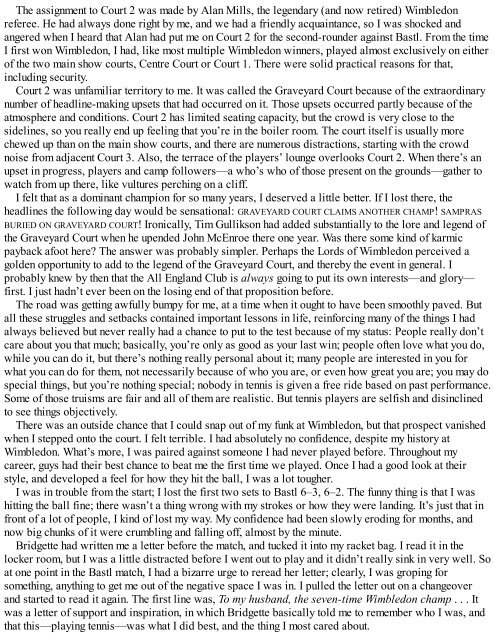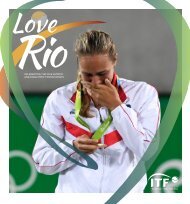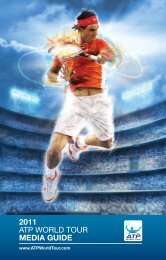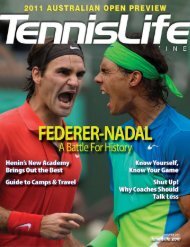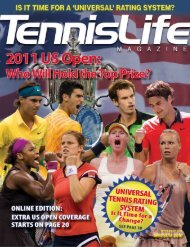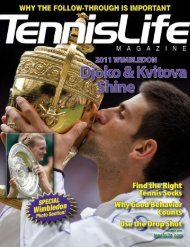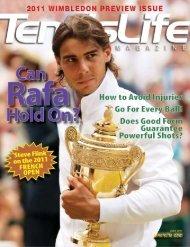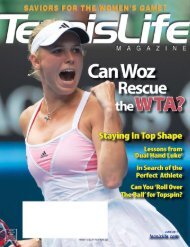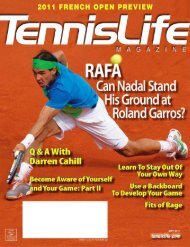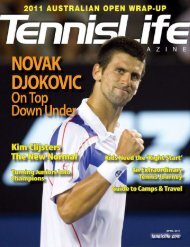A Champion's Mind - Pete Sampras
www.tennismoscow.me Insta:TENNISMOSCOW
www.tennismoscow.me Insta:TENNISMOSCOW
Create successful ePaper yourself
Turn your PDF publications into a flip-book with our unique Google optimized e-Paper software.
The assignment to Court 2 was made by Alan Mills, the legendary (and now retired) Wimbledon<br />
referee. He had always done right by me, and we had a friendly acquaintance, so I was shocked and<br />
angered when I heard that Alan had put me on Court 2 for the second-rounder against Bastl. From the time<br />
I first won Wimbledon, I had, like most multiple Wimbledon winners, played almost exclusively on either<br />
of the two main show courts, Centre Court or Court 1. There were solid practical reasons for that,<br />
including security.<br />
Court 2 was unfamiliar territory to me. It was called the Graveyard Court because of the extraordinary<br />
number of headline-making upsets that had occurred on it. Those upsets occurred partly because of the<br />
atmosphere and conditions. Court 2 has limited seating capacity, but the crowd is very close to the<br />
sidelines, so you really end up feeling that you’re in the boiler room. The court itself is usually more<br />
chewed up than on the main show courts, and there are numerous distractions, starting with the crowd<br />
noise from adjacent Court 3. Also, the terrace of the players’ lounge overlooks Court 2. When there’s an<br />
upset in progress, players and camp followers—a who’s who of those present on the grounds—gather to<br />
watch from up there, like vultures perching on a cliff.<br />
I felt that as a dominant champion for so many years, I deserved a little better. If I lost there, the<br />
headlines the following day would be sensational: GRAVEYARD COURT CLAIMS ANOTHER CHAMP! SAMPRAS<br />
BURIED ON GRAVEYARD COURT! Ironically, Tim Gullikson had added substantially to the lore and legend of<br />
the Graveyard Court when he upended John McEnroe there one year. Was there some kind of karmic<br />
payback afoot here? The answer was probably simpler. Perhaps the Lords of Wimbledon perceived a<br />
golden opportunity to add to the legend of the Graveyard Court, and thereby the event in general. I<br />
probably knew by then that the All England Club is always going to put its own interests—and glory—<br />
first. I just hadn’t ever been on the losing end of that proposition before.<br />
The road was getting awfully bumpy for me, at a time when it ought to have been smoothly paved. But<br />
all these struggles and setbacks contained important lessons in life, reinforcing many of the things I had<br />
always believed but never really had a chance to put to the test because of my status: People really don’t<br />
care about you that much; basically, you’re only as good as your last win; people often love what you do,<br />
while you can do it, but there’s nothing really personal about it; many people are interested in you for<br />
what you can do for them, not necessarily because of who you are, or even how great you are; you may do<br />
special things, but you’re nothing special; nobody in tennis is given a free ride based on past performance.<br />
Some of those truisms are fair and all of them are realistic. But tennis players are selfish and disinclined<br />
to see things objectively.<br />
There was an outside chance that I could snap out of my funk at Wimbledon, but that prospect vanished<br />
when I stepped onto the court. I felt terrible. I had absolutely no confidence, despite my history at<br />
Wimbledon. What’s more, I was paired against someone I had never played before. Throughout my<br />
career, guys had their best chance to beat me the first time we played. Once I had a good look at their<br />
style, and developed a feel for how they hit the ball, I was a lot tougher.<br />
I was in trouble from the start; I lost the first two sets to Bastl 6–3, 6–2. The funny thing is that I was<br />
hitting the ball fine; there wasn’t a thing wrong with my strokes or how they were landing. It’s just that in<br />
front of a lot of people, I kind of lost my way. My confidence had been slowly eroding for months, and<br />
now big chunks of it were crumbling and falling off, almost by the minute.<br />
Bridgette had written me a letter before the match, and tucked it into my racket bag. I read it in the<br />
locker room, but I was a little distracted before I went out to play and it didn’t really sink in very well. So<br />
at one point in the Bastl match, I had a bizarre urge to reread her letter; clearly, I was groping for<br />
something, anything to get me out of the negative space I was in. I pulled the letter out on a changeover<br />
and started to read it again. The first line was, To my husband, the seven-time Wimbledon champ . . . It<br />
was a letter of support and inspiration, in which Bridgette basically told me to remember who I was, and<br />
that this—playing tennis—was what I did best, and the thing I most cared about.


